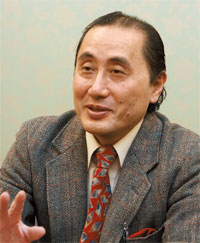A Theory for the Salvation of Korea (Part 2)
Korea Has Not Understood the Spirit of Modernization: An Interview With Masanori Mizuma

Masanori Mizuma
Researcher of Modern History,
In 1950, Mr. Mizuma was born in the Hokkaido region of Japan. At Keio University’s Faculty of Law, he focused on political science, but Mr. Mizuna didn’t finish his degree. He’s now on a mission to disprove falsehoods concerning modern history that television and the press have been reporting based solely on primary sources. Mr. Mizuma’s most important books include the following: “The Truth on ‘Japan’s Annexation of the Korean Peninsula’ Reported by Asahi Newspaper” (Tokuma Shoten); “Straight to the Point Truth on ‘Prewar Japan”; “Straight to the Point, Bushido Psychology During the ‘Sino-Japanese War’ Era”.
In Korean dramas that depict the Joseon era Korea, one often sees gorgeous costumes, but the common people in Joseon did not have cheap dyes to use at the time, most of them actually wore basic white clothes.
The dramas also depict endless factional struggles, where in the end the side that is stronger or victorious gets the win. It’s been historically characteristic of the Korean Peninsula not to judge matters based on truth or falsity, and Korea has not changed to this day.
The culture of writing history down is especially weak due to the fact that every time there is a regime change, the new leadership purges the writer of the records of the previous regime. For that reason, as you can see from the comfort women controversy, Koreans lack the practice of verifying historical facts from sources, and they don’t clarify the truth.
In Japan, there has been a tradition of promise keeping since before the Meiji period. During the end of the Edo era, even when Western countries made unfair treaties with them, Japanese leaders used negotiations to win back extraterritoriality and tariff autonomy. Even when Japan encountered prejudice within the international community, it struggled over 40 years to strengthen the country through the development of modern industry.
Yet, Korea does not have a history of toiling in blood and sweat for the sake of modernization. After the Russo-Japanese War ended, and Japan protected the state, and suddenly only the fruits of modernization were brought.
Up until that time, the condition in Joseon was such that sewage water ran down the sides of streets, and Koreans didn’t even use horse wagons. During the modernization effort, the Japanese, who brought the benefits to Korea one after the other, must have seemed like aliens who had descended from the skies.
The Benefits of the Annexation Era
To ensure the rule of national law in the Korean Peninsula, Japan introduced a three-court system for trials. In addition, thanks to people like the first Resident-General of Korea, Hirobumi Ito, who establishted the school system, there were some 6000 schools at the end of the Annexation era, whereas before there were only about 100 of them. The Japanese built many great three-story elementary schools out of brick, even before they did in Japan. It emphatically did not look to exploit the Korean Peninsula as a colony. The historical truth was that Japan tried to modernize Korea.
Japan invested and built up everything such as the Korean Bank for arranging a monetary economy, a museum for nurturing a culture where documents could be saved, a hydroelectric dam that was unthinkable in Joseon times, the greatest iron drawbridge in Asia, and a railway spanning over 5000 km with over 1000 stations.
The “Indulgence Structure” of Korea
The spirit of modernization did not unfortunately take hold in Korea. For instance, even as Japan introduced the three-court system, Korea did not attain the rule of law, and it could not understand its significance. In fact, to this day it has not shed its tendency to make emotional judgments based on loss or gain.
Even after the war, Koreans continued to make many unreasonable requests. After they experienced the kindness of the Japanese during the Annexation era, the Koreans couldn’t get enough of the good life, but they weren’t grateful to Japan for it.
In the 1970s, Korea enjoyed high rates of economic growth known as the “Miracle of Han River,” but it was actually due to Japan. It aided Korea with funding that equaled two years of the country’s national budget based on an agreement in the Japan-Korea Basic Treaty.
Whenever Korea’s economy turns sour, it starts to bring up absurdities like the comfort women controversy, but it also continues to receive monetary aid from Japan. The Koreans have put an “indulgence structure” in place when they relate to Japan.
Another big difference with Japan is that Buddhism never took root in the Korean Peninsula. A policy, known as “Demolishing Buddha Statues and Revering Confucianism” during the Joseon era, suppressed Buddhism and only a handful of temples remained deep in the mountains. As was the case with China, regions that rejected Buddhism did not mix well with Japan, even when the areas were geographic close.
In Buddhism, there are such things as compassion and the Bodhisattva’s way of life, where believers selflessly help people. However, the Koreans and Chinese frown upon such practices, and they even considered them idiotic.
For Korea to become truly modern, it needs to make an effort to build trust within the international community as Japan has done. (This marks the end of interview.)



















